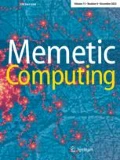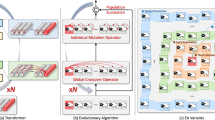Abstract
Recently, hyperspectral image classification is attracting more and more attention. Since every pixel is represented by a high dimensional spectral vector, the ordinary machine learning algorithms usually require a large number of training samples to solve this problem. However, collecting labeled samples is time-consuming, which forces us to improve existing algorithms. Motivated by evolutional algorithms (EAs), we propose location based DNA matching algorithm for hyperspectral image classification. It aims mainly on the shortcomings such as requirement for large number of labeled samples and inseparable spectral values. It is based on EA and can be segmented into three subtasks. In the first encoding procedure, some spatial information is added to the spectral values to solve the problem of spectral mixture to some extent. In the second evolutional procedure, we introduce elite-preserving strategy and totally random operators within a specific exemplar, which can prevent deterioration and can also search for solutions in a large space. Aiming at the compared pixel-wise algorithms will end up with lots of mislabeled points in a region, we add the third procedure which utilizes some labeled samples’ locations to optimize the intermediate result. Compared with three state-of-the-art algorithms, simulation results suggest the effectiveness of the proposed algorithm.









Similar content being viewed by others
References
Chakravortty S, Sinha D, Bhondekar A (2015) Assessment of urbanization of an area with hyperspectral image data[C]. In: Proceedings of the 3rd international conference on frontiers of intelligent computing: theory and applications (FICTA) 2014. Springer, pp 315–322
Shang X, Chisholm LA (2014) Classification of Australian native forest species using hyperspectral remote sensing and machine-learning classification algorithms. IEEE J Sel Top Appl Earth Obs Remote Sens 7(6):2481–2489
Nasrabadi NM (2014) Hyperspectral target detection: an overview of current and future challenges. IEEE Signal Process Mag 31(1):34–44
Lampropoulos GA, Liu T, Qian SE et al (2008) Hyperspectral classification fusion for classifying different military targets[C]. IGARSS 2008–2008 IEEE international geoscience and remote sensing symposium, vol 3. IEEE, pp III-262–III-265
Hughes G (1968) On the mean accuracy of statistical pattern recognizers. IEEE Trans Inf Theory 14(1):55–63
Camps-Valls G, Gomez-Chova L, Muñoz-Marí J et al (2006) Composite kernels for hyperspectral image classification. IEEE Geosci Remote Sens Lett 3(1):93–97
Tuia D, Pacifici F, Kanevski M et al (2009) Classification of very high spatial resolution imagery using mathematical morphology and support vector machines. IEEE Trans Geosci Remote Sens 47(11):3866–3879
Liu D, Li J (2016) Data field modeling and spectral-spatial feature fusion for hyperspectral data classification. Sensors 16(12):2146
Li H, Ye Z, Xiao G (2015) Hyperspectral image classification using spectral-spatial composite kernels discriminant analysis. IEEE J Sel Top Appl Earth Obs Remote Sens 8(6):2341–2350
Davis JC (1996) Introduction to statistical pattern recognition: 2nd edition, by Keinosuke Fukunaga, Academic Press, San Diego, 1990, 591 p., ISBN 0-12-269851-7, US$69.95. Comput Geosci 22(7):833–834
Lee C, Landgrebe DA (1993) Feature extraction based on decision boundaries. IEEE Trans Pattern Anal Mach Intell 15(4):388–400
Lim S, Sohn KH, Lee C (2001) Principal component analysis for compression of hyperspectral images. In: Geoscience and remote sensing symposium, 2001. IGARSS’01. IEEE, International, vol 1. IEEE, pp 97–99
Rasti B, Ulfarsson MO, Sveinsson JR (2016) Hyperspectral feature extraction using total variation component analysis. IEEE Trans Geosci Remote Sens 54(12):6976–6985
Cheng S, Shi Y, Qin Q (2015) Population diversity of particle swarm optimizer solving single- and multi-objective problems. Emerg Res Swarm Intell Algorithm Optim 3:71–98
Tuia D, Volpi M, Copa L et al (2011) A survey of active learning algorithms for supervised remote sensing image classification. IEEE J Sel Top Signal Process 5(3):606–617
Bruzzone L, Chi M, Marconcini M (2006) A novel transductive SVM for semisupervised classification of remote-sensing images. IEEE Trans Geosci Remote Sens 44(11):3363–3373
Nekkaa M, Boughaci D (2015) A memetic algorithm with support vector machine for feature selection and classification. Memet Comput 7(1):59–73
Xue Z, Li J, Cheng L et al (2015) Spectral-spatial classification of hyperspectral data via morphological component analysis-based image separation. IEEE Trans Geosci Remote Sens 53(1):70–84
Srinivas U, Chen Y, Monga V et al (2013) Exploiting sparsity in hyperspectral image classification via graphical models. IEEE Geosci Remote Sens Lett 10(3):505–509
Ma A, Zhong Y, Zhao B et al (2016) Semisupervised subspace-based DNA encoding and matching classifier for hyperspectral remote sensing imagery. IEEE Trans Geosci Remote Sens 54(8):4402–4418
Shi Y (2015) An optimization algorithm based on brainstorming process. Emerg Res Swarm Intell Algorithm Optim 2:1–35
Cheng S, Qin Q, Chen J, Shi Y (2016) Brain storm optimization algorithm: a review. Artif Intell Rev 46(4):445–458
Shen XN, Han Y, Fu J (2017) Robustness measures and robust scheduling for multi-objective stochastic flexible job shop scheduling problems. Soft Comput 21(21):6531–6554
Shi Y (2016) Developmental swarm intelligence: developmental learning perspective. Nat Inspired Comput Concepts Methodol Tools Appl Concepts Methodol Tools Appl 2:349
Zhang M, Ma J, Gong M (2017) Memetic algorithm based feature selection for hyperspectral images classification. In: IEEE congress on evolutionary computation (CEC), et al (2017). IEEE, pp 495–502
Chang CC, Lin CJ (2011) LIBSVM: a library for support vector machines. ACM Trans Intell Syst Technol (TIST) 2(3):27
Tropp JA, Gilbert AC (2007) Signal recovery from random measurements via orthogonal matching pursuit. IEEE Trans Inf Theory 53(12):4655–4666
Qian Y, Ye M, Zhou J (2013) Hyperspectral image classification based on structured sparse logistic regression and three-dimensional wavelet texture features. IEEE Trans Geosci Remote Sens 51(4):2276–2291
Bernard K, Tarabalka Y, Angulo J et al (2012) Spectral-spatial classification of hyperspectral data based on a stochastic minimum spanning forest approach. IEEE Trans Image Process 21(4):2008–2021
Fauvel M, Tarabalka Y, Benediktsson JA et al (2013) Advances in spectral-spatial classification of hyperspectral images. Proc IEEE 101(3):652–675
Acknowledgements
This work was partially supported by the National Natural Science Foundation of China, under Grants 61773304, 61371201, and 61772399, the Program for Cheung Kong Scholars and Innovative Research Team in University under Grant IRT_15R53.
Author information
Authors and Affiliations
Corresponding author
Rights and permissions
About this article
Cite this article
Shang, R., Lan, Y. & Jiao, L. A novel location-based DNA matching algorithm for hyperspectral image classification. Memetic Comp. 11, 175–191 (2019). https://doi.org/10.1007/s12293-018-0257-6
Received:
Accepted:
Published:
Issue Date:
DOI: https://doi.org/10.1007/s12293-018-0257-6




